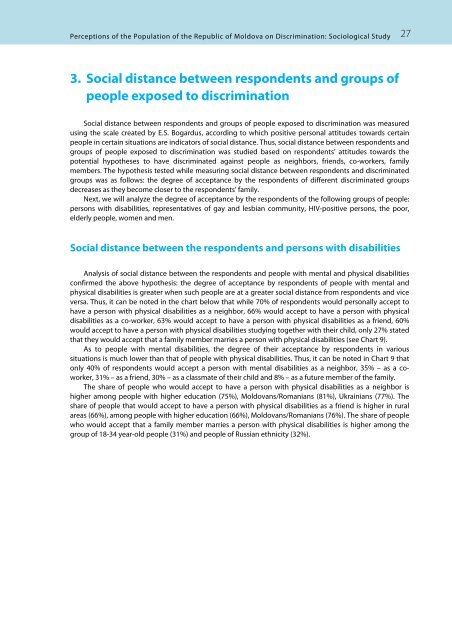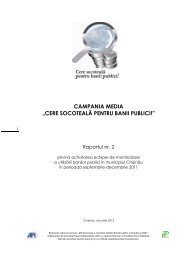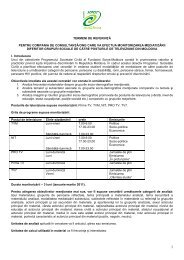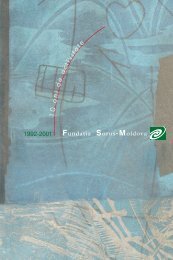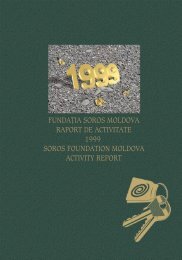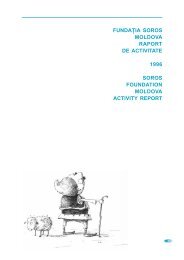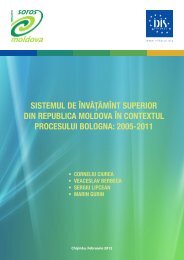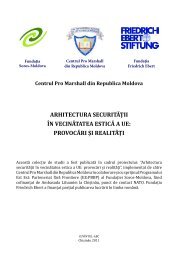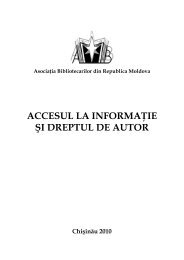<strong>Perceptions</strong> <strong>of</strong> <strong>the</strong> <strong>Population</strong> <strong>of</strong> <strong>the</strong> <strong>Republic</strong> <strong>of</strong> <strong>Moldova</strong> on Discrimination: Sociological Study 26“Roma people are rejected and despised by <strong>the</strong> society, being looked at as second-class people. Roma pupilsand students do not have opportunities to study in <strong>the</strong>ir mo<strong>the</strong>r tongue. People <strong>of</strong> Roma ethnicity arediscriminated in <strong>the</strong> labor field, are not <strong>of</strong>fered employment and are despised at workplace. They do not have fullaccess to quality medical services.”The high competition on <strong>the</strong> labor market, <strong>the</strong> low level <strong>of</strong> education <strong>of</strong> Roma people or, sometimes,even <strong>the</strong> lack <strong>of</strong> any education result in <strong>the</strong>ir exclusion from <strong>the</strong> labor market.“Children do not finish school; <strong>the</strong>y do not have studies or specific qualifications to be able to accessemployment opportunities. Citizens <strong>of</strong> <strong>Moldova</strong> display little tolerance towards people who are different, andconsequently it is very difficult for Roma people to integrate.”The attitude towards Roma is fuelled in <strong>the</strong> experts’ opinion by a number <strong>of</strong> prejudices existing in <strong>the</strong>society regarding <strong>the</strong>ir deviant behavior. Because <strong>of</strong> such an attitude Roma people are deprived <strong>of</strong> <strong>the</strong>irright to participate in <strong>the</strong> decision-making process at both local and national levels.“There are a number <strong>of</strong> prejudices in <strong>the</strong> society regarding Roma. They are given as an example <strong>of</strong> badconduct even by <strong>the</strong> highest-ranking public <strong>of</strong>ficials. Also, given such prejudices, <strong>the</strong>y do not have full access topublic <strong>of</strong>fices, to health care and education services.”WomenAccording to <strong>the</strong> perception <strong>of</strong> <strong>the</strong> general public, women are discriminated most upon employment(+24), at workplace (+29) and in <strong>the</strong> political life (+19).During <strong>the</strong> Delphi study, <strong>the</strong> experts shared a similar opinion. Discrimination at workplace in <strong>the</strong>iropinion is expressed by <strong>the</strong> fact that women are hired to less valuable positions than men, are paid lessthan men and cannot advance in career similarly to men.“In <strong>the</strong> <strong>Republic</strong> <strong>of</strong> <strong>Moldova</strong> women comprise 53% <strong>of</strong> population and still <strong>the</strong> condition <strong>of</strong> women in oursociety is ra<strong>the</strong>r difficult, being affected by <strong>the</strong> consequences <strong>of</strong> <strong>the</strong> economic crisis, but also by <strong>the</strong>ir status <strong>of</strong>mo<strong>the</strong>r and wife which <strong>the</strong>y have <strong>of</strong>ten to combine with <strong>the</strong> status <strong>of</strong> family provider. In <strong>the</strong> <strong>Republic</strong> <strong>of</strong> <strong>Moldova</strong>women’s wage is about 72% <strong>of</strong> that <strong>of</strong> men, women are discriminated in <strong>the</strong> labor field based on <strong>the</strong>irmatrimonial status and age, because <strong>of</strong> <strong>the</strong> supposed amount <strong>of</strong> time <strong>the</strong>y dedicate to family life.”The experts think also that <strong>the</strong> discrimination <strong>of</strong> women in political sphere is manifested by <strong>the</strong> lowpercentage <strong>of</strong> women in high-ranking positions in <strong>the</strong> Government Parliament, as well as in local anddistrict public administration.Some experts expressed <strong>the</strong> view that <strong>the</strong> discrimination <strong>of</strong> women has its roots in <strong>the</strong> Christianchurch. Thus, <strong>the</strong>y think that “woman is discriminated by <strong>the</strong> Christian church, being viewed as a surplus, as anaid to man.”Thus, after analyzing <strong>the</strong> perception <strong>of</strong> <strong>the</strong> general public, as well as <strong>the</strong> experts’ opinions on <strong>the</strong> socialcontexts in which different groups are discriminated, we can conclude that most <strong>of</strong> <strong>the</strong> disadvantagedgroups are exposed to discrimination in various contexts. Thus, disabled people frequently facediscrimination upon employment, at workplace, in education and medical institutions and in relations withauthorities. HIV-positive persons are discriminated upon employment, at workplace, in medical andeducation institutions, as well as in <strong>the</strong>ir own families. Representatives <strong>of</strong> gay and lesbian community arediscriminated in family, in medical institutions, at workplace and in public life, being deprived <strong>of</strong> <strong>the</strong> rightto assembly and public manifestations. Women are discriminated in particular at workplace and in politicallife, being insufficiently represented in <strong>the</strong> political process at both national and local levels. In <strong>the</strong>respondents’ and experts’ opinions, <strong>the</strong> poor is one <strong>of</strong> <strong>the</strong> most disadvantaged and discriminated groups in<strong>the</strong> <strong>Republic</strong> <strong>of</strong> <strong>Moldova</strong>. The chronic lack <strong>of</strong> financial resources limits <strong>the</strong>ir access to quality education andhealth services.After computing <strong>the</strong> Average Dominant Personal Opinion Index (ADPOI) <strong>of</strong> <strong>the</strong> general public for eachgroup, we can conclude that, depending on <strong>the</strong> seven analyzed social contexts, <strong>the</strong> most discriminatedgroups, in <strong>the</strong> respondents’ opinion, are: disabled people (-25), <strong>the</strong> poor (-25), and HIV-positive persons (-22), and <strong>the</strong> least discriminated: women (+34) and <strong>the</strong> Roma people (+10).
<strong>Perceptions</strong> <strong>of</strong> <strong>the</strong> <strong>Population</strong> <strong>of</strong> <strong>the</strong> <strong>Republic</strong> <strong>of</strong> <strong>Moldova</strong> on Discrimination: Sociological Study 273. Social distance between respondents and groups <strong>of</strong>people exposed to discriminationSocial distance between respondents and groups <strong>of</strong> people exposed to discrimination was measuredusing <strong>the</strong> scale created by E.S. Bogardus, according to which positive personal attitudes towards certainpeople in certain situations are indicators <strong>of</strong> social distance. Thus, social distance between respondents andgroups <strong>of</strong> people exposed to discrimination was studied based on respondents’ attitudes towards <strong>the</strong>potential hypo<strong>the</strong>ses to have discriminated against people as neighbors, friends, co-workers, familymembers. The hypo<strong>the</strong>sis tested while measuring social distance between respondents and discriminatedgroups was as follows: <strong>the</strong> degree <strong>of</strong> acceptance by <strong>the</strong> respondents <strong>of</strong> different discriminated groupsdecreases as <strong>the</strong>y become closer to <strong>the</strong> respondents’ family.Next, we will analyze <strong>the</strong> degree <strong>of</strong> acceptance by <strong>the</strong> respondents <strong>of</strong> <strong>the</strong> following groups <strong>of</strong> people:persons with disabilities, representatives <strong>of</strong> gay and lesbian community, HIV-positive persons, <strong>the</strong> poor,elderly people, women and men.Social distance between <strong>the</strong> respondents and persons with disabilitiesAnalysis <strong>of</strong> social distance between <strong>the</strong> respondents and people with mental and physical disabilitiesconfirmed <strong>the</strong> above hypo<strong>the</strong>sis: <strong>the</strong> degree <strong>of</strong> acceptance by respondents <strong>of</strong> people with mental andphysical disabilities is greater when such people are at a greater social distance from respondents and viceversa. Thus, it can be noted in <strong>the</strong> chart below that while 70% <strong>of</strong> respondents would personally accept tohave a person with physical disabilities as a neighbor, 66% would accept to have a person with physicaldisabilities as a co-worker, 63% would accept to have a person with physical disabilities as a friend, 60%would accept to have a person with physical disabilities studying toge<strong>the</strong>r with <strong>the</strong>ir child, only 27% statedthat <strong>the</strong>y would accept that a family member marries a person with physical disabilities (see Chart 9).As to people with mental disabilities, <strong>the</strong> degree <strong>of</strong> <strong>the</strong>ir acceptance by respondents in varioussituations is much lower than that <strong>of</strong> people with physical disabilities. Thus, it can be noted in Chart 9 thatonly 40% <strong>of</strong> respondents would accept a person with mental disabilities as a neighbor, 35% – as a coworker,31% – as a friend, 30% – as a classmate <strong>of</strong> <strong>the</strong>ir child and 8% – as a future member <strong>of</strong> <strong>the</strong> family.The share <strong>of</strong> people who would accept to have a person with physical disabilities as a neighbor ishigher among people with higher education (75%), <strong>Moldova</strong>ns/Romanians (81%), Ukrainians (77%). Theshare <strong>of</strong> people that would accept to have a person with physical disabilities as a friend is higher in ruralareas (66%), among people with higher education (66%), <strong>Moldova</strong>ns/Romanians (76%). The share <strong>of</strong> peoplewho would accept that a family member marries a person with physical disabilities is higher among <strong>the</strong>group <strong>of</strong> 18-34 year-old people (31%) and people <strong>of</strong> Russian ethnicity (32%).


